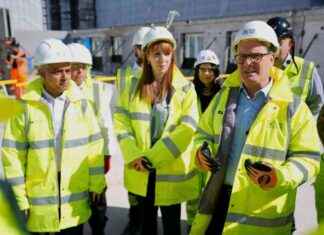The former ultra-conservative head of the Judicial Authority thus confirms the fears aroused by his accession to power in August 2021, succeeding the more moderate Hassan Rohani.
Especially since Mr. Raisi and the Supreme Leader, Ayatollah Ali Khamenei, have to face an acute economic crisis, largely due to Western sanctions targeting the Iranian nuclear program, and a series of disasters, including the deadly collapse of a building in Abadan (South) in May, amid accusations of incompetence and corruption, which sparked an unusual dispute.
“The current repression is intimately linked to the increase in demonstrations,” Ali Fathollah-Nejad, an Iran specialist at the American University of Beirut (AUB), told AFP.
The regime learned the lessons of the national protest in December 2017 and then in November 2019 and, although the motivations for the demonstrations are initially socio-economic, “they quickly become political and target the whole system”, underlines t -he.
“Street demonstrations continue to pose a threat to the stability of the regime,” said Fathollah-Nejad.
The increase in the number of executions in Iran, described by Amnesty International as a “frenzy”, is spectacular: they have doubled in the first half of the year compared to the same period in 2021, according to the NGO Iran Human Rights (IHR), based in Oslo, which recorded 316 hangings in 2022.
The regime also carried out its first public execution in over two years in July.
Among those executed this year are 10 women, IHR reports, three of them on the same day, July 27, all for the murder of their husbands.
Iran has also resumed the amputation of the fingers of convicts for theft, a punishment inflicted on at least two of them since May by means of a specially installed guillotine at Evin prison in Tehran, according to Amnesty.
“The authorities are using these waves of executions to instill fear in society to deter any anti-government demonstrations,” said IHR director Mahmood Amiry Moghaddam.
The protest against the death penalty in Iran – the second country in number of executions, just behind China – is however flourishing on social networks, expressed by the hashtag “edam nakon” (“do not execute”).
One of the voices of this movement, the filmmaker Mohammad Rasoulof, winner of the Golden Bear 2020 in Berlin for his film “The devil does not exist”, was arrested in July for having co-signed an open letter in May urging the security forces to “lay down their arms” in the face of anger against “corruption, theft, incompetence and repression”.
His comrade Jafar Panahi, star of Iranian cinema abroad, who came to inquire about his fate, was then arrested and sent to Evin prison to serve a six-year sentence handed down in 2010.
Parents fighting for the release of victims of the November 2019 crackdown have also found themselves behind bars.
Tara Sepehri Far, researcher on Iran at Human Rights Watch (HRW), also sees in these recent arrests “cynical maneuvers to dissuade the expression of the indignation of the population at the many failures of the government”, denouncing ” the repressive reflex of the authorities consisting in arresting popular critics”.
Representatives of the Baha’i community, the largest non-Muslim religious minority in Iran, also denounce a series of arrests over the past two months.
In addition, about twenty nationals of Western countries, including many dual nationals whose dual nationality Iran does not recognize, remain detained or stranded in the country, according to the Center for Human Rights in Iran (CHRI), based in New York.
NGOs accuse Tehran of taking them hostage to obtain concessions from foreign powers.
If several have benefited in recent months from sentence adjustments, even releases, this is not the case of Jamshid Sharmahd, an Iranian-German dissident captured in August 2020 in a Gulf country, according to his family.
Accused of involvement in an attack that killed 14 people in April 2008, he is currently on trial in Tehran.
His trial should be completed in the coming weeks, he faces the death penalty.






